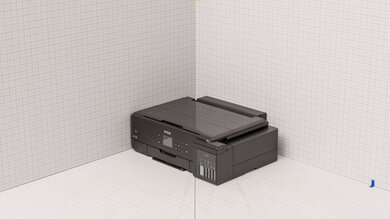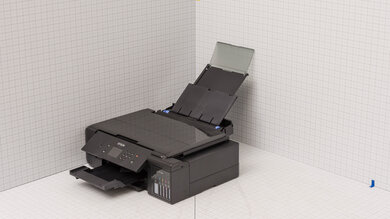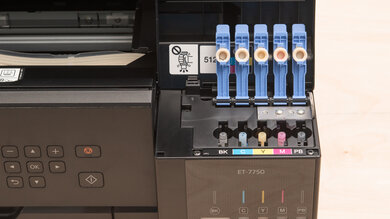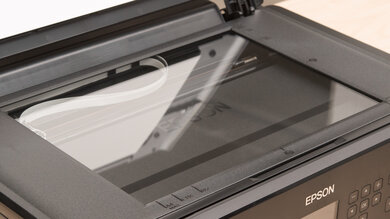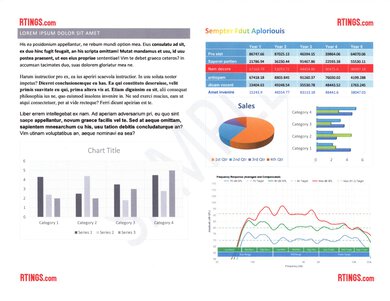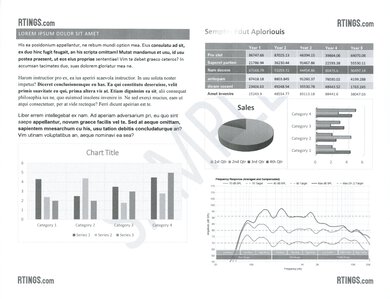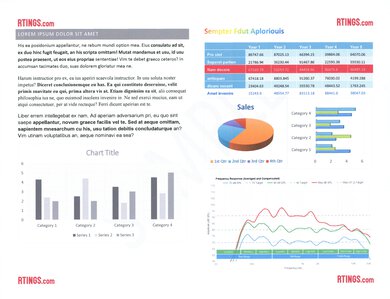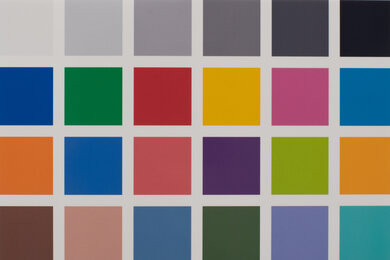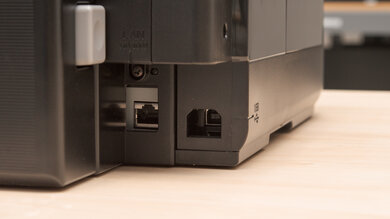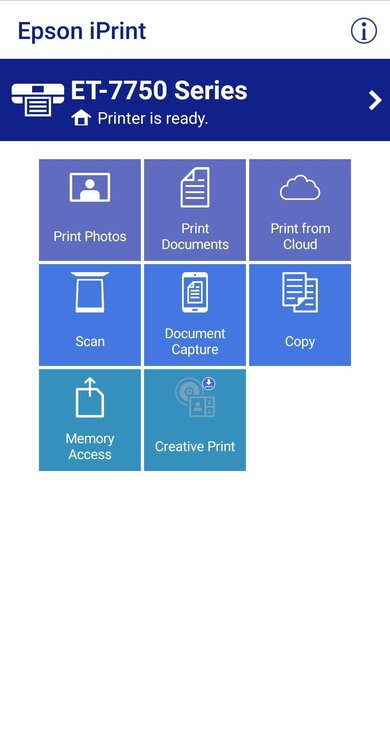The Epson EcoTank ET-2800/2803 is an all-in-one supertank inkjet printer that uses Epson's T522 ink. It has a 1.5-inch display, an 8.5" x 11" flatbed scanner with no automatic feeder or fax functionality, and a 100-sheet input tray. It has Wi-Fi and USB connectivity, supports Apple AirPrint and Mopria Print Service, and is compatible with Epson's Smart Panel mobile app. The Epson EcoTank ET-2803 is the same printer but is exclusive to Walmart and Target retailers. Our review applies to both models.
Our Verdict
The Epson EcoTank ET-2800/Epson EcoTank ET-2803 performs well for family use. Its inexpensive ink bottle refills and incredible page yields mean it's remarkably cheap to maintain in the long run, easing the load on your wallet. It prints great-looking, vibrant photos, and its color accuracy is fine for everyday use. It has a high-resolution flatbed scanner, but the lack of an automatic document feeder makes digitizing multi-page documents cumbersome, as you'll have to scan each page manually.
-
Produces sharp-looking documents.
-
High page yields, low cost per print.
-
Produces very fine details in pictures.
-
Produces high-quality scans.
-
Wide color range.
-
Photos are a bit grainy.
The Epson ET-2800/Epson ET-2803 is satisfactory for small or home office use. Its supertank ink system gives it incredibly high page yields, meaning you don't often have to spend time refilling its ink tanks. Unfortunately, it isn't suited for busy workplaces since it prints slowly and doesn't have an ADF-equipped scanner to easily digitize multi-page documents. Additionally, it doesn't have an Ethernet port to ensure a stable network connection.
-
Produces sharp-looking documents.
-
High page yields, low cost per print.
-
Produces high-quality scans.
-
Fairly quick at getting short print jobs done.
-
Prints slowly.
-
No automatic document feeder.
-
No Ethernet port.
-
Doesn't support automatic duplex printing.
The Epson EcoTank ET-2800/Epson EcoTank ET-2803 is a great printer for students. Maintaining the printer is cheap thanks to its outstandingly low cost-per-print, and its incredibly high-yielding supertank ink system can supply a semester's worth of print jobs. You can easily digitize notes and reading materials and even convert them into searchable PDFs using its flatbed scanner and OCR software. It's a bit slow to print, so it's best to set aside time to let it print even short documents.
-
Produces sharp-looking documents.
-
High page yields, low cost per print.
-
Produces high-quality scans.
-
Fairly quick at getting short print jobs done.
-
Prints slowly.
The Epson ET-2800/Epson ET-2803 is decent if you mainly need to print in black and white. It has incredible page yields and a superb cost-per-print. Unfortunately, while it warms up fairly quickly, its actual print speed is rather slow, so you'll be waiting around for a while when printing longer documents. Scanning longer documents is also an exercise in patience, as it lacks an automatic document feeder to quickly process multiple pages.
-
Produces sharp-looking documents.
-
High page yields, low cost per print.
-
Produces high-quality scans.
-
Prints slowly.
-
No automatic document feeder.
-
Doesn't support automatic duplex printing.
The Epson EcoTank ET-2800/Epson EcoTank ET-2803 performs decently as a photo printer. It uses dye-based inks, producing great-looking photos with high contrast. While colors look vibrant, their accuracy is only alright, so printed photos likely won't look quite like the originals. There's also a noticeable amount of grain, and the contrast is sometimes too high, resulting in a loss of detail in dark and bright sections of images.
-
High page yields, low cost per print.
-
Produces very fine details in pictures.
-
Compatible with a wide variety of paper sizes.
-
Wide color range.
-
Photos are a bit grainy.
- Family
- Small/Home Office
- Student
- Black & White
- Photo
Performance Usages
- Color Quality
- Document Quality
- Scanner
- Speed
- Recurring Costs
- Updated Jan 26, 2024: Minor in-text adjustments to further clarify product details.
- Updated Oct 18, 2023: Added mention of the Epson EcoTank ET-2840 Special Edition as an alternative with better scan quality in the Scan Quality section.
- Updated Sep 27, 2023: Added mention of the Canon PIXMA G4270 as an alternative that produces higher quality color documents in the Color Documents section.
- Updated Feb 08, 2023: We've changed the name of the printer to include the Epson EcoTank ET-2803 since it's the same printer.
- Updated Jan 25, 2023: We've updated the review to improve clarity and added more information in the Scan Quality, Black and White Documents, Color Documents, and Small Details sections.
- Updated Jan 19, 2023: We've updated the review with more specificity regarding the tested model and its variant.
- Updated Aug 25, 2022: Converted to Test Bench 1.2.
- Updated Jul 04, 2022: Converted to Test Bench 1.1.
- Updated Apr 04, 2022: While you can't select A5 in the print settings, you can set custom sizes, which would let you print on A5-sized paper. We updated the Printing Size box to say "Yes" for A5.
- Updated Feb 14, 2022: Review published.
- Updated Feb 09, 2022: Early access published.
- Updated Jan 20, 2022: Our testers have started testing this product.
- Updated Jan 04, 2022: The product has arrived in our lab, and our testers will start evaluating it soon.
- Updated Nov 23, 2021: We've purchased the product and are waiting for it to arrive in our lab.
Differences Between Sizes And Variants
This printer has two color variants: 'White' and 'Black.' This printer is sold as the Epson EcoTank ET-2803 at Walmart and Target.
See our unit's label here.
Compared To Other Printers
The Epson EcoTank ET-2800/Epson EcoTank ET-2803 is a great printer overall and a good choice for households that print a lot due to its high page yields and low cost-per-print. However, it has slow printing speeds and lacks many features that other printers in its class have, like an automatic document feeder, Ethernet connectivity, and automatic duplex printing.
For more options, see our recommendations for the best home printers, the best photo printers, and the best inkjet printers.
The HP Smart Tank 7301 [6001, 7001] is better for most uses than the Epson EcoTank ET-2800/2803. While both printers are all-in-one supertank models, the HP is more feature-rich, with an ADF-equipped scanner and ethernet connectivity. It also prints faster at 12 black and six color pages per minute, and color documents are more saturated and detailed than the Epson. However, if you print a lot of photos, then the Epson is the better choice for you. Colors look vibrant thanks to the use of dye-based inks, and although there is some graining in the print quality, it is fine for casual or at-home photo printing.
The Epson EcoTank ET-2800/ET-2803 and the Epson EcoTank ET-2850 are very similar supertank printers. The biggest difference is that the ET-2850 prints more black pages and can print double-sided sheets automatically. However, the ET-2800 has much better color accuracy and produces more fine details in photos. It also produces higher-quality scans.
The Epson EcoTank ET-2800/ET-2803 and the Epson EcoTank ET-4800/ET-4810 are very similar printers. If you scan many documents for work, the ET-4800 has an automatic document feeder, so it's more convenient since you don't need to scan each page individually. Also, it has an Ethernet port if you want to plug it directly into your router for a faster connection. Otherwise, both perform very similarly.
The Epson EcoTank ET-2800/ET-2803 and the Epson EcoTank ET-3850 are both all-in-one supertank printers, but the ET-3850 performs better overall. The ET-3850 has higher page yields for both black and color documents, faster printing speeds, an automatic document feeder, and Ethernet connectivity. On the other hand, the ET-2800 produces better-looking photos with more details and better color accuracy.
The Epson EcoTank ET-2400 and the Epson EcoTank ET-2800/ET-2803 are very similar all-in-one inkjet supertank printers. They're nearly identical in features; the only difference is that the ET-2800 has a better display panel, making it easier to navigate the settings menu. It also supports Apple AirPrint and Mopria Print Service. The ET-2400's scanner picks up finer details and produces higher-quality scans; however, it also boosts the contrast and saturation more, which you may or may not like, depending on whether accuracy is important to you.
The Epson EcoTank ET-2800/ET-2803 and the Epson EcoTank ET-4850 are both all-in-one supertank printers, but the ET-4850 performs much better overall. The ET-4850 is more feature-rich, as it has an automatic document feeder and Ethernet connectivity; it also performs better, with higher page yields for both black and color documents, faster printing speeds, and better-quality black and color documents. On the other hand, the ET-2800 produces better-looking photos with more details and better color accuracy.
The Epson EcoTank ET-2840 Special Edition and the Epson EcoTank ET-2800/ET-2803 are nearly identical. The ET-2840 is better, as it yields more prints and produces slightly higher-quality black-and-white documents. The ET-2840 also comes with two additional bottles of black ink.
The Epson EcoTank ET-2800/ET-2803 and the Brother MFC-J4335DW are both inkjet models, but the Epson uses a refillable supertank ink system, while the Brother uses a hybrid high-yield cartridge–tank system. The Brother performs better for home office, student use, and black and white printing, as it prints significantly faster and supports duplex printing. Additionally, it has an automatic document feeder that scans multi-page documents quickly. The Epson yields significantly more black and color pages at a much cheaper cost-per-print, produces significantly better-looking photos with deeper contrast, and produces a much wider range of colors with better accuracy.
The Epson EcoTank ET-2800 and Canon PIXMA G3270 trade blows. The Canon is the more versatile printer as it offers more features, such as a height-adjustable scanner lid to accommodate thicker documents and better connectivity options like support for Apple AirPrint and Mopria Print Service. The Canon also has a substantially higher page yield. By contrast, if you print a lot of photos, then the Epson is the better choice, as it offers a noticeably wider color gamut and better color accuracy. Also, its scanner produces better-looking scans, as those by the Canon are overly grainy, and fine details don't appear as clearly.
The Canon PIXMA G6020 and Epson EcoTank ET-2800/ET-2803 are all-in-one inkjet printers with refillable ink tanks. The Canon is slightly better overall as it's more feature-rich than the Epson. It offers a much larger input tray capacity of 350 pages and automatic duplex printing, which is great if you have a large print load and need to print many double-sided documents. By contrast, the Epson produces nicer-looking scans and more color-accurate and vivid photos. It's a good choice for at-home photo printing.
The Epson EcoTank ET-2800/ET-2803 is much better than the HP Smart Tank 5101. The Epson produces nicer photos due to its wider color range and superior color accuracy. Its scanner performs better, as it can capture finer details, making it a better option for digitizing photos. While both printers have a high page yield, the HP requires more maintenance, as its printheads clog more easily and are hard to unclog.
The Canon MegaTank MAXIFY GX2020/GX1020 is a better printer than the Epson EcoTank ET-2800/ET-2803. Although the Epson's ink tanks grant it a higher page yield than the GX2020, the Canon has a much faster print speed, pushing out up to 13 black and nine color pages per minute. Print quality for black and color documents is also better on the Canon; however, if you plan on printing many photos, then the Epson may be a better choice. Photos look much better than those from the Canon, which appear overly warm and have a line pattern throughout that obscures small details.
The Canon PIXMA G3260/G3262 and the Epson EcoTank ET-2800/ET-2803 are both color inkjets with supertank ink systems that perform similarly. The Canon requires less maintenance as it yields much more black and color pages, and the cost-per-print for color documents and photos is much cheaper. On the other hand, the Epson produces better scans and more fine details in photos.
The Canon PIXMA G7020 and the Epson EcoTank ET-2800/ET-2803 are similar supertank inkjet printers. However, Canon is the better choice for most uses. If you need to scan often, the Canon has an automatic document feeder and an adjustable hinge, allowing you to scan thicker items like textbooks. Also, it prints faster, yields many more pages, and offers a lower cost-per-print, making it the ideal choice if you have a large print load. Where the Epson edges out the Canon is with photos; the ET-2800 offers superior color accuracy, so there are only a few noticeable differences when comparing prints with originals. While it's not accurate enough for professional use, if you print a lot of photos at home, then the Epson is better for your usage.
The Epson EcoTank Pro ET-5850 is better than the Epson EcoTank ET-2800/ET-2803 for most uses. The ET-5850 yields much more black pages, prints significantly faster, and supports automatic duplex printing making it easier to print double-sided documents. Additionally, it has an automatic document feeder with duplex scanning and an Ethernet port, and it can print directly from external USB storage. On the other hand, the ET-2800 yields much more color prints, and its replacement ink is cheaper, making it less costly to maintain over time.
The Epson EcoTank ET-2800/ET-2803 and the Epson EcoTank ET-3760 are both color inkjets with supertank ink systems. The ET-3760 is better for small or home office use as it has an automatic document feeder, its cost-per-print is fractionally cheaper, and it prints documents much faster. Additionally, it prints many more black pages before needing a refill, supports automatic duplex printing, and has an Ethernet port. On the other hand, the ET-2800 is better for photo printing as it produces more detailed and color-accurate photos.
The Epson EcoTank ET-2800/2803 is a significantly better printer than the HP DeskJet 3755/3772, but they're very different models. The HP is a basic compact printer that yields an extremely low number of black and color pages, has a high cost-per-print, and prints much slower than the Epson. By contrast, the Epson is an all-in-one supertank printer; thanks to its reservoir, it yields a high number of pages and has a low cost per print. Print quality is also great, as black and color documents look good, and scans are also excellent.
The Epson EcoTank ET-2800/ET-2803 and the Epson EcoTank ET-2720 are both inkjets with supertank ink systems, but the ET-2800 is a newer model that performs a bit better. The ET-2800 yields more black pages, prints slightly faster, and supports duplex printing, albeit you need to manually flip the pages over. Also, the ET-2800 prints much better-quality photos, with deeper blacks and more accurate colors. On the other hand, the ET-2720 has a wider color gamut, meaning it can produce more vibrant colors. It doesn't support automatic or manual duplex printing, though, so the printer doesn't prompt you to turn over the sheets or your document at all if you want to print on both sides.
The Epson EcoTank ET-2760 and the Epson EcoTank ET-2800/ET-2803 are both supertank inkjet printers. The ET-2800 produces much better-looking photos with deeper blacks and significantly better color accuracy. However, the ET-2760 yields significantly more black and color pages, supports automatic duplex printing, and can print directly from SD cards.
The Canon PIXMA G4270 is slightly better than the Epson EcoTank ET-2800/ET-2803 for most uses. The Canon feels more sturdily built, produces higher quality documents, and yields significantly more prints. It also has an automatic document feeder and fax functionality. However, the Epson produces better photos, and its scanner captures finer details, making it a better choice for digitizing pictures and graphics.
Test Results
This printer's plastic body feels relatively sturdy. There aren't any creaks or squeaky noises from moving parts, and the input connections feel solid. However, the paper tray cover at the top rear of the printer feels thin and flimsy. The design isn't particularly user-friendly, as it's difficult to access the sheet rollers to remove paper jams, and there isn't a dampener to prevent the scanner's lid from slamming down.
Like all inkjets, the printheads can clog if you don't print for a long time. If you experience clogging or other print quality issues, this printer has many built-in maintenance functions that can help resolve them, including printhead nozzle checks, regular and power printhead cleaning, and printhead alignment. There's also a paper guide cleaning function to remove dirt or loose ink to prevent prints from getting smeared as they go through the feeders.
You won't have to worry about filling the ink tank very often due to the printer's high page yield. Refilling the tank is easy, as the bottles have keyed nozzles that only fit the corresponding ink tank, so it's almost impossible to put the wrong ink into the tanks. On the other hand, the input tray will need regular refilling, as it only holds 100 sheets of plain paper or 20 sheets of photo paper. Also, it's difficult to access the sheet rollers to clear paper jams, as you have to raise the control panel first, pull down the front inner cover, then lift the scanning bed until it clicks into place. There's little in the way of clearance, and you must also be careful not to touch the printing tubes.
See the user manual here.
This printer has a mediocre display. It's very small, so you must lean in close to see properly. There isn't a numeric keypad, only directional keys, so setting up the printer and connecting it to your network is very cumbersome. The screen doesn't have good viewing angles, meaning you'll have to look at it straight on, but fortunately, you can tilt the entire front panel a full 90 degrees upwards.
This printer doesn't use ink cartridges. It uses an ink tank that you can refill with bottles of ink. A full tank yields a large number of prints, so it's a great choice for high-volume printing. While you can technically use third-party ink refills, we didn't try it and don't recommend doing so. Low-quality ink can damage the printheads, and unlike standard inkjet printers, you can't simply remove a cartridge if there's a problem.
The ET-2800 yields significantly more cyan pages than either magenta or yellow. While it isn't clear exactly why this is the case, it's good news for people who intend to print blues often, like graphic designers working with a specific color palette or casual photographers specializing in landscape photos with lots of sky or ocean. It doesn't have an ink level sensor but instead monitors ink usage internally to estimate when the ink levels run low. To get the most accurate estimate, you need to fill the ink tanks properly and reset the ink levels manually in the printer settings. It's best not to allow the ink tanks to run too low, as this can introduce air bubbles into the tubes and damage the printer.
This printer only has a flatbed scanner, so it isn't ideal for people who frequently digitize multi-page documents. The scanner's lid hinges don't properly raise to fit thicker items like textbooks for scanning, unlike other printers. Instead, you can actually remove the scanner lid entirely. To do this, you first have to open the lid fully, then gently push forward one hinge at a time until each one releases entirely from the hinge mechanism. Remember, the lid's white background won't cover any exposed spaces that the item you're scanning doesn't cover, so any direct copies will result in those exposed regions coming out completely black. This could potentially use up lots of ink or result in unusable prints.
If you want an EcoTank printer that has an automatic document feeder, check out the Epson EcoTank ET-3850 or the Epson EcoTank ET-4800/ET-4810.
The scan quality is great. The scanner boosts the contrast and saturation. This is good for text documents because it makes the text easier to read, but it might not be ideal if you prioritize accuracy. The image processing also removes some finer details. If you want a similar all-in-one with better scan quality, check out the Epson EcoTank ET-2840 Special Edition.
- Start Here Guide
- Setup CD
- Power cord
- Epson T522 ink bottles:
- 1x black
- 1x cyan
- 1x magenta
- 1x yellow
The print quality of black and white documents is great. Most text looks sharp, but smaller text on colored backgrounds looks blurry. All of the fine elements come through properly and more clearly than when printing in color. It has trouble converting the color yellow to grayscale, although that's normal for most printers.
The print quality of color documents is good. Again, except for some smaller text on colored backgrounds, most text looks clear. However, colors look slightly washed out, and not all of the finer details come through properly. If you want a similar printer that produces better color documents, check out the Canon PIXMA G4270.
This printer's cost-per-print is remarkably low, thanks to its high page yield and cheap ink refills. Also, the printer comes with a set of full bottles in the box, rather than limiting you to half-filled starter cartridges that need replacing not long after you get the printer.

This printer isn't all that fast. It takes a while to print out long documents, like reports or colored worksheets. Printing a typical photo also takes a while, much longer than most inkjet printers. On the bright side, initializing and getting single-page prints out doesn't take too long. When printing double-sided documents, you need to manually flip the first set of printed pages over when prompted and reinsert them into the feeder so the printer can finish printing the other side. If you want an EcoTank that automatically prints double-sided, check out the Epson EcoTank ET-2850.
This printer doesn't have a removable paper cassette, only an input feeder at the top rear of the printer. You can set custom sizes between 2.12" and 8.5" in width and 3.39" and 47.24" in length. It has a plastic extender to hold sheets and a movable slider to properly align differently sized media types. However, you need to manually extend and retract the front output tray, which could be inconvenient as printed sheets can fall off if you don't catch them.
This printer has a good color gamut. It can produce bright, saturated colors but struggles with darker shades of green and yellow.
The color accuracy is okay. Casual prints look great, with only a few noticeable differences from the original image, which is sufficient for occasionally printing out family photos. That said, it might not be accurate enough for enthusiasts or professionals.
This printer is outstanding at reproducing small details. The main issue is the halftones (dot effect), making edges and distant objects look less defined.
The Epson Smart Panel mobile app is feature-rich. You can use it to print, scan, and copy, as well as perform maintenance tasks, like cleaning the printheads, checking the printhead nozzles, and viewing the estimated ink levels. You can also buy ink refills and update the printer's firmware. The app alerts you if some documents can't be displayed or printed properly; otherwise, it'll automatically convert most files into a printable format without any manual intervention.
This printer is fully compatible with the most commonly used operating systems. On Windows, you only need to install the printer's drivers if you just want to print, but you need to install the Epson Scan 2 software if you want to use all the scanning features. You can print and scan on Chrome OS and macOS devices without manually installing an application or drivers.



